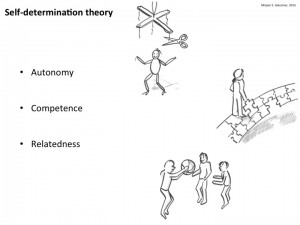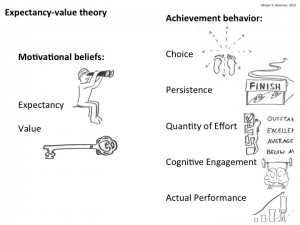
And even more on motivation
Last week we talked about motivation quite a bit: First about why do students engage in academic tasks?, then about how motivation is proportional to the expectation of achieving a goal. Today I want to bring it all together a bit more, by presenting two other theories (both also described in the Torres-Ayala and Herman (2012) paper, which — should you not have read it yet — I strongly recommend you look into!).
The self-determination theory describes three components of motivation: Autonomy (i.e. being able to determine what you learn, when you learn it and how you learn it), competence (feeling like what you are learning is giving you (more) options to achieve what you want to achieve) and relatedness (feeling connected to a group).

Self-determination theory
Those are all components that you, the instructor, do have some influence on. For example a feeling of autonomy can be fostered as easily as giving students the choice of three problem sets and asking them to choose the one they want to work on. Or to let them choose the group they want to work with rather than prescribing groups yourself. Or even only letting them determine the order in which you talk about homework questions.
A feeling of competence is a little more difficult for you to influence, but can be achieved by giving problem sets that gradually become more difficult, instead of giving them really challenging problems right away.
And a feeling of relatedness can be achieved for example by letting students choose who they want to work with, and by making sure you observe the group processes and intervene when necessary.
So far, so good.
There is a fourth theory in the paper, that I also drew little pictures for, but which when preparing for my upcoming workshop for TU Dresden, I chose to drop for now. After all, there is only so much theory one can take in at a time, and I know that what the participants of the workshop come for are methods, methods, methods. Which I might actually give them!
Anyway, I still want to look at the expectancy-value theory here.
Expectancy-value theory basically connects motivational beliefs with achievement behavior.
If you believe you can achieve your goal (expectancy) and reaching that goal is important to you (value), this will modify your behavior. For example, you will likely choose to practice more, and on harder problems than people who don’t have the same beliefs. You will likely be more persistent in pursuing your goal. The quality of your effort will be higher, your cognitive engagement will be higher, and your actual performance will also be better.
There are a lot of studies that link student beliefs with their behavior, and I find this super interesting. I’ll definitely get back to reading and writing about this very soon!
—
Ana T. Torres-Ayala, & Geoffrey L. Herman (2012). Motivating Learners: A Primer for Engineering Teaching Assistants. American Society for Engineering Education
